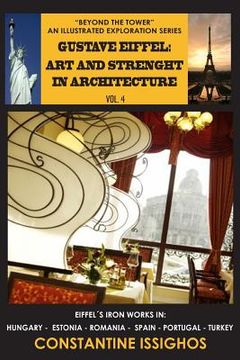Gustave Eiffel: Art and Strength in Architecture: The Eiffel Illustrated Exploration Series (en Inglés)
Reseña del libro "Gustave Eiffel: Art and Strength in Architecture: The Eiffel Illustrated Exploration Series (en Inglés)"
The Vol. 1 " Beyond the Tower"of the Eiffel Illustrated Exploration Series covers Eiffel's iron works in Mexico, USA and Ecuador. The Vol. 2 " Art of Metal Structures" covers Eiffel Iron Works in Peru, and Chile, the Vol. 3 " Genius of Iron Works" covers Eiffel's iron works in Argentine and Bolivia. These 3 Vol. completes Eiffel's entire Iron Works in the Americas. This is the 4th volume " Art and Strength in Architecture" in the Eiffel Exploration Series. It covers the Eiffel Iron Works in Portugal and Spain, Vol.5 "The Magician of Iron" presents Eiffel's historical monuments in Southern France, Vol.6 "The Iron Lady" concentrates on Eiffel's creations on the city of Paris including the famous Eiffel Tower, Vol.7 "Gustave Eiffel: Contribution to Belle Epoque" narrates Eiffel's iron works in central-France, Vol. 8 "Gustave Eiffel: Visionary Engineer and Scientist" describes Eiffel's various metal structures and his contribution to telecommunications and aerodynamics. "Gustave Eiffel: Place in History" narrates Eiffel's Iron projects in Eastern-Europe, Latvia, Hungary, Romania and Turkey. Gustave Eiffel designed the structures of many, now famous, artistic architectural buildings and structures around the world. All of those buildings and structures were made with iron support system. While other architects were attracted to Romanesque style, Eiffel was discovering the Industrial Revolution style of balancing iron columns and beams in harmony with the Art of Industrial Heritage. As such, Eiffel created a cultural landscape out of the material used in the Industrial Revolution. During the last part of the Industrial Revolution in the 19th century, the timber and masonry tradition of constructing buildings, viaducts, bridges and aqueducts was coming to an eclipse by the expanded use of iron which was much cheaper and stronger than stone. Bridges and buildings could now be constructed with wrought iron or cast-iron and any thickness of metal plates could be utilized for exterior or interior walls. Eiffel's artistic designing skills were remarkable as we can also witness in the engineering structures of Saint Joseph Church of of 1863, the massive skylight glass roof of Mussee de la Mode in 1873, and the exposed iron-works of the magnificent Synagogue of Toulouse. These two metals, cast-iron and wrought-iron components can be found in buildings such as the Palacio de Hierro in Orizaba, Mexico, or on the walls of the San Marco's Church in Arica, Chile, among others. Now, let us consider the 1875 Royal Portuguese Railway Company's choice of an engineering structural design for a bridge to serve the Lisbon-Porto railway traffic across the inhospitable river gorge of the fast flowing Douro River---the Maria Pia Bridge. As shown in the pictures taken of the Maria Pia Bridge, the beauty of this bridge is in the strength of its industrial style wrought-iron material and style of metal work. Its two-hinged crescent arch was built to carry the load of the railway for the 350 meter trip across the River Douro at 60 meters height above the river's surface. On its inauguration day in 1877, the Maria Pia Bridge was the longest single iron arch in the world. Its design was very simple yet extremely graceful and its single arch is effective and efficient against strong winds and fast flowing water. In any case, part of the success of Eiffel's Maria Pia bridge was that it inspired other structural engineers to pay attention to societal components of bridges. The bridges functioned to allow the movement of goods and people across inhospitable terrains and river gorges. A good number of Eiffel's bridges served the Industrial Revolution demand for more railway transportation, so this helped expand the infrastructure of Portugal and Spain and many other countries In Europe, Asia and South America. Therefore, Eiffel earned the name "The Magician of Iron."

